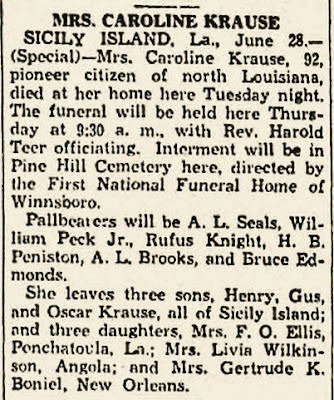On March 15, 1955 the post office at Foules in Catahoula Parish was closed and mail was re-routed to Clayton in Concordia Parish. The closure of the Foules post office brought an end to eighty-three years of
Bowman family members serving as postmasters in Ward One; an area which included post offices at Wildwood, Lee Bayou and Foules.
The first postmaster appointed to the Wildwood post office was Francis J. "Frank" Bowman. His appointment was issued on June 26,1872.
Postmasters at Wildwood:
1872 - Francis J. "Frank" Bowman
1877 - Henrietta Eliza "Etta" Bruce Bowman (wife of Frank Bowman)
1888 - Charles Orvey Bowman (nephew of Frank; son of Samuel S. Bowman)
1891 - Henrietta Eliza "Etta" Bruce Bowman
1891 - May Eliza Davis Bowman (wife of Charles Orvey Bowman)
1920 - Anabel P. Register Bowman (wife of William Homer Bowman)
On December 31, 1920 the post office at Wildwood was discontinued and mail was re-routed to Lee Bayou.
Postmasters at Lee Bayou:
1902 - Ernest F. Gillespie
1903 - Charles R. Gillespie
1905 - Thomas W. Gray
1906 - Henry E. Hoover
1917 - William Homer Bowman (son of Charles Orvey Bowman)
1923 - May Eliza Davis Bowman (wife of Charles Orvey Bowman)
The Lee Bayou post office was discontinued on October 23, 1935. Mail was re-routed to the Foules post office on November 15, 1935.
 |
| Monroe News Star - 4/21/1936 |
Postmasters at Foules:
1900 - Thomas F. Hall
1901 - J. E. Johnson
1901 - William A. Wiggins
1904 - Watson S. Finister
1905 - John W. Beasley
1907 - Oliver M. Martin
1908 - Marvin Lee Banyon
1908 - Watson Finister
1912 - William E. McGraw
1924 - Lydia R. McGraw
1931 - Anabel P. Register Bowman
1935 - William Homer Bowman
On March 15, 1955 the post office at Foules was discontinued and mail was re-routed to Clayton in Concordia Parish. This not only ended the presence of a post office in the Ward One area but it also ended over eighty years of Bowman family members serving as postmasters.
 |
| Monroe News Star - 3/25/1955 |


















































